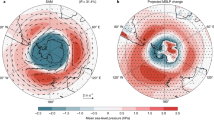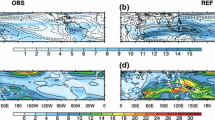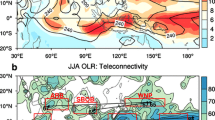Summary
Observational studies indicate that the convective activity of the monsoon systems undergo intraseasonal variations with multi-week time scales. The zone of maximum monsoon convection exhibits substantial transient behavior with successive propagating from the North Indian Ocean to the heated continent. Over South Asia the zone achieves its maximum intensity. These propagations may extend over 3000 km in latitude and perhaps twice the distance in longitude and remain as coherent entities for periods greater than 2–3 weeks. Attempts to explain this phenomena using simple ocean-atmosphere models of the monsoon system had concluded that the interactive ground hydrology so modifies the total heating of the atmosphere that a steady state solution is not possible, thus promoting lateral propagation. That is, the ground hydrology forces the total heating of the atmosphere and the vertical velocity to be slightly out of phase, causing a migration of the convection towards the region of maximum heating. Whereas the lateral scale of the variations produced by the Webster (1983) model were essentially correct, they occurred at twice the frequency of the observed events and were formed near the coastal margin, rather than over the ocean.
Webster's (1983) model used to pose the theories was deficient in a number of aspects. Particularly, both the ground moisture content and the thermal inertia of the model were severely underestimated. At the same time, the sea surface temperatures produced by the model between the equator and the model's land-sea boundary were far too cool. Both the atmosphere and the ocean model were modified to include a better hydrological cycle and ocean structure. The convective events produced by the modified model possessed the observed frequency and were generated well south of the coastline.
The improved simulation of monsoon variability allowed the hydrological cycle feedback to be generalized. It was found that monsoon variability was constrained to lie within the bounds of a positive gradient of aconvective intensity potential (I). The function depends primarily on the surface temperature, the availability of moisture and the stability of the lower atmosphere which varies very slowly on the time scale of months. The oscillations of the monsoon perturb the mean convective intensity potential causing local enhancements of the gradient. These perturbations are caused by the hydrological feedbacks, discussed above, or by the modification of the air-sea fluxes caused by variations of the low level wind during convective events. The final result is the slow northward propagation of convection within an even slower convective regime. The ECMWF analyses show very similar behavior of the convective intensity potential. Although it is considered premature to use the model to conduct simulations of the African monsoon system, the ECMWF analysis indicates similar behavior in the convective intensity potential suggesting, at least, that the same processes control the low frequency structure of the African monsoon. The implications of the hypotheses on numerical weather prediction of monsoon phenomenon are discussed.
Similar content being viewed by others
References
Anthes, A. R., 1977: A cumulus parameterization scheme utilizing a one-dimensional cloud model.Mon. Wea. Rev.,105, 270–286.
COARE: The TOGA Coupled Ocean Atmosphere Response Experiment, TOGA COARE Science Plan, WMO Publication, Addendum No. 3.
Flohn, H., 1960: Equatorial westerlies over Africa, their extension and significance. In: Bargman, D. J. (ed.)Tropical Meteorology in Africa. Nairobi: Munitalp Foundation, 253–267.
Gadgil S., Asha, G., 1988: Poleward propagations of the intertropical convergence zone. Rev. 88 AS 2, Centre for Atmospheric Sciences, Indian Institute of Science, Bangalore, India.
Gadgil, S., Asha, G., 1991: On poleward propagations of the intertropical convergence zone.Mon. Wea. Rev. (submitted).
Gray, W. M., 1968: Global view of the origin of tropical disturbances and storms.Mon. Wea. Rev.,96, 669–700.
Goswami, B. N., Shukla, J., 1984: Quasi-periodic oscillations in a zonally symmetric general circulation model.J. Atmos. Sci.,41, 20–37.
Hahn, D. G., Manabe, S., 1975: The role of mountains in the South Asian monsoon.J. Atmos. Sci.,32, 1515–1541.
Halley, E., 1686: An historical account of the trade winds and the monsoons, observable between and near the tropics, with an attempt to assign the physical cause of the said winds.Phil. Trans. Roy. Soc. London,16, 153–168.
Hansen, J., Russell, G., Rind, D., Stone, P., Lacis, A., Lebedeff, S., Ruedy, R., Travis, L., 1983: Efficient 3-dimensional global models for climate studies: Models I and II.Mon. Wea. Rev.,111, 609–662.
Hartmann, D. L., Gross, J. R., 1988: Seasonal variability of the 40–50 day oscillation in wind and rainfall in the tropics.J. Atmos. Sci.,45, 2680–2702.
Hastenrath, S., Lamb, P., 1979:Climatic Atlas of Indian Ocean Part I. Madison: The University Wisconsin Press.
Hastenrath, S., 1988:Climate and Circulation of the Tropics. Dordecht: Atmospheric Sciences Library, D. Radel Publishing, Co., 455 pp.
Hendl, M., 1963:Systematische Klimatologie. Berlin: Veb Deutscher Verlag der Wissenschaften.
Johnson, D. H., 1962: Rain in East Africa.Quart. J. Roy. Meteor. Soc.,88, 1–19.
Krishnamurti, T. N., 1979:Compendium of Meteorology, Vol. II, Part 4. Geneva, Switzerland: World Meteorological Organization.
Krishnamurti, T. N., Bhalme, H. H., 1976: Oscillations of a monsoon system. Part I: Observational aspects.J. Atmos. Sci.,33, 1937–54.
Lukas, R., Lindstrom, E., 1987: The mixed layer of the western Pacific Ocean. In: Muller, P., Henderson, D. (eds.)Proceedings of the “Aha Huliko‘a’Hawaiian Winter Workshop on the Dynamics of the Oceanic Surface Mixed Layer”. Honolulu, Hawaii, Hawaii Institute of Geophysics Special Institute Pub., pp. 69–74.
Madden, R. D., Julian, P., 1971: Detection of a 40–50 day oscillation in the zonal wind in the tropical Pacific.J. Atmos. Sci.,28, 702–708.
McBride, J. L., 1983: Satellite observations of the southern hemisphere monsoon during Winter MONEX.Tellus,35A, 189–197.
Nicholson, S. E., 1980: The nature of rainfall fluctuations in subtropical West Africa.Mon. Wea. Rev.,108, 473–487.
Ooyama, K., 1969: Numerical simulation of the life cycle of tropical cyclones.J. Atmos. Sci.,26, 3–40.
Palmer, T. N., 1986: Influence of the Atlantic, Pacific and Indian Oceans on Sahel rainfall.Nature,322, 251–253.
Ramage, C. S., 1971:Monsoon Meteorology. (International Geophysics Series,15) New York: Academic Press, 296 pp.
Sikka, D. R., Gadgil, S., 1980: On the maximum cloud zone and the ITCZ over Indian longitudes during the Southwest monsoon.Mon. Wea. Rev.,108, 1840–1853.
Stephens, G. L., 1978: Radiative properties of extended water clouds, Part I.J. Atmos. Sci.,35, 2111–2122.
Stephens, G. L., Webster, P. J., 1981: Clouds and climate: Sensitivity of simple systems.J. Atmos. Sci.,38, 235–247.
Walker, H. O., 1960: The monsoon in West Africa. In: Basu, S. et al. (eds.)Monsoons of the World. New Delhi: Hind Press, pp. 35–42.
Webster, P. J., 1983: Mechanism of monsoon low frequency variability: Surface hydrological effects.J. Atmos. Sci.,40, 2110–2124.
Webster, P. J., 1987: The variable and interactive monsoon. In: Fein, J. S., Stephens, P. L. (eds.)Monsoons. New York: John Wiley and Sons, 269–330.
Webster, P. J., Lau, K. M. W., 1977: A simple ocean-atmosphere climate model: Basic model and a simple experiment.J. Atmos. Sci.,34, 1063–1084.
Webster, P. J., Chou, L., 1980a: Seasonal structure of a simple monsoon structure.J. Atmos. Sci.,37, 354–367.
Webster, P. J., Chou, L., 1980b: Low frequency transitions of a simple monsoon system.J. Atmos. Sci.,37, 368–382.
Webster, P. J., Lukas, R., 1992: TOGA COARE: The Coupled Ocean — Atmosphere Response Experiment.Bull. Amer. Meteor. Soc.,73, 1377–1416.
Yang, S., 1990: Atmospheric teleconnections: Emphasis on El Niño/Southern Oscillation and Monsoons, Ph.D. Thesis, The Pennsylvania State University, 228 pp.
Yasunari, T., 1979: Cloudiness fluctuations associated with the northern hemisphere summer monsoon.J. Met. Soc. Japan,57, 227–242.
Author information
Authors and Affiliations
Rights and permissions
About this article
Cite this article
Srinivasan, J., Gadgil, S. & Webster, P.J. Meridional propagation of large-scale monsoon convective zones. Meteorl. Atmos. Phys. 52, 15–35 (1993). https://doi.org/10.1007/BF01025750
Received:
Issue Date:
DOI: https://doi.org/10.1007/BF01025750




